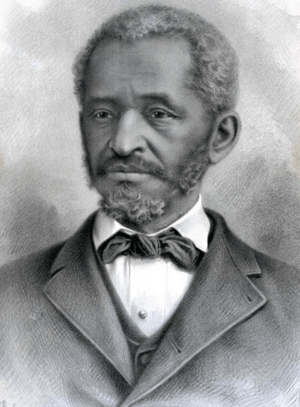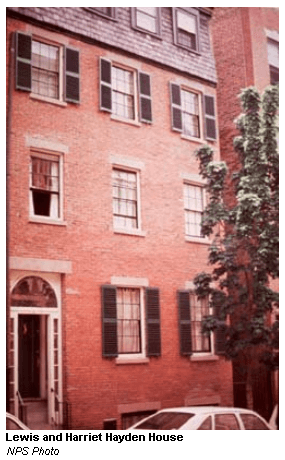Lewis Hayden facts for kids
Quick facts for kids
Lewis Hayden
|
|
|---|---|
 |
|
| Member of 1873 Massachusetts legislature |
|
| In office 1872–1873 |
|
| Personal details | |
| Born | December 2, 1811 Kentucky |
| Died | April 7, 1889 (aged 77) |
| Political party | Republican |
| Spouse | Harriet Hayden |
Lewis Hayden (born December 2, 1811 – died April 7, 1889) was an important American leader. He escaped slavery in Kentucky with his family. They found freedom in Canada. Later, he moved to Boston, Massachusetts. There, he became a strong voice against slavery.
Hayden was a speaker, a businessman, and a politician. Before the American Civil War, he and his wife, Harriet Hayden, helped many enslaved people escape. They often hid them in their home, which was a stop on the Underground Railroad. In 1873, Hayden was elected to the Massachusetts state legislature. He also helped start many black groups of Freemasons. His home in Boston is now a National Historic Site on the Black Heritage Trail.
Lewis Hayden's Life Story
Growing Up Enslaved
Lewis Hayden was born into slavery in Lexington, Kentucky, in 1811. He was one of 25 children in his family. His mother had a mixed background, including African, European, and Native American roots. Lewis's father was also enslaved and was sold away early in Lewis's life.
Lewis was first owned by a minister. When Lewis was 10, the minister sold him for two horses. His new owner traveled the state selling clocks. This allowed Lewis to hear different ideas about slavery. Some people even called it a crime. When he was 14, a famous soldier, Marquis de Lafayette, tipped his hat to Lewis. This made Lewis feel worthy of respect and hate slavery even more.
In the 1830s, Lewis married Esther Harvey, who was also enslaved. Sadly, she and their son were sold to the Deep South. Lewis never saw them again. In the 1840s, Lewis taught himself to read, even though his owner would whip him for it.
Lewis asked two men, Lewis Baxter and Thomas Grant, to buy him. He suggested they hire him out for work. He wanted to keep some of his earnings to buy his freedom. They agreed and bought him. Lewis worked at the Phoenix Hotel in Lexington and began saving money.
By 1842, Lewis married again to Harriet Bell, who was also enslaved. He cared for her son, Joseph, as his own. Harriet and Joseph were owned by another person. After marrying, Lewis feared his new family might be split up. He began planning their escape to the North.
Escape to Freedom
In 1844, Lewis met Calvin Fairbank, a minister involved in the Underground Railroad. Fairbank asked Lewis why he wanted freedom. Lewis replied, "Because I am a man."
Fairbank and Delia Webster, a teacher, helped the Haydens escape. They used a carriage and traveled from Lexington to Ripley, Ohio. The Haydens put flour on their faces to look white and avoid being caught. When there was danger, they hid Joseph under the seat. Other abolitionists helped them continue north along the Underground Railroad. They finally reached Canada, where slavery was illegal.
When Fairbank and Webster returned to Kentucky, they were arrested. Fairbank was sentenced to 15 years in prison. After four years, Lewis Hayden helped free him. Lewis, living in Boston, quickly raised $650 from 160 people to pay for Fairbank's pardon.
In 1845, the Haydens moved from Canada to Detroit, Michigan. Detroit was a major stop for people escaping slavery. Lewis started a school for black children there. He also helped build a church. By 1846, Lewis and his family moved to Boston, Massachusetts. Boston was a center for the anti-slavery movement. Lewis opened a clothing store there.
Fighting Against Slavery
Speaking Out for Freedom
In Massachusetts, Lewis Hayden became a traveling speaker for the American Anti-Slavery Society. He shared his experiences and beliefs. In 1847, Lewis and Harriet were on a train to Vermont. The conductor would not let them sit in first class because of their race. The Haydens protested. The railroad then gave them a special first-class car just for them.
Lewis faced challenges as a speaker. He wrote to the society, "You all know it is me jest three years from slavery... I shall do all I can to make myself a man." He showed great determination.
Helping on the Underground Railroad

The Haydens' home in Boston was a safe house for people escaping slavery. Many people stayed there. Guests included Ellen and William Craft, who escaped in 1848. Lewis Hayden protected the Crafts from slave catchers. He threatened to blow up his house with gunpowder if they tried to take them. Records show that the Hayden home helped many people between 1850 and 1860.
The famous author Harriet Beecher Stowe, who wrote Uncle Tom's Cabin, visited the Haydens. She came to learn more about the lives of escaped slaves. She saw 13 newly escaped slaves at their home.
Running a Business
In 1849, Lewis opened a clothing store. It became the second-largest business owned by a black man in Boston. Later, a financial crisis caused him to close the store. He then sold jewelry.
Joining the Vigilance Committee
Lewis Hayden was a member of the Boston Vigilance Committee. This group helped protect and aid escaped slaves in the city. He worked closely with other activists. Lewis was known for his brave actions against the Fugitive Slave Act of 1850. This law made it easier for slave owners to reclaim escaped slaves.
Lewis helped rescue Shadrach Minkins, an escaped slave, from federal custody in 1851. Lewis was arrested and tried for this, but the jury could not agree. He also helped in other rescue attempts. Lewis even gave money to John Brown, who led a famous raid against slavery.
Political Life
Lewis Hayden strongly supported John Albion Andrew, who became governor in 1861. Hayden was the first to suggest that Andrew run for governor. Governor Andrew even had Thanksgiving dinner at the Haydens' home in 1862. Lewis was given a job as a messenger in the Secretary of State's office.
In 1873, Hayden was elected to the Massachusetts General Court. He served as a representative for Boston. He supported building a statue for Crispus Attucks. Attucks was a black and Native American man who was the first person killed in the Boston Massacre. Lewis was too sick to attend the statue's unveiling in 1888, but many friends honored him there.
In the 1880s, Hayden helped Julius Caesar Chappelle get involved in politics. Chappelle became a popular Republican lawmaker. Hayden helped Chappelle register black voters, which was very successful.
Freemason Leader
Lewis Hayden was very active in the Freemasons. This is a social and charitable organization. Many black members worked to end slavery. Hayden spoke out against racial unfairness within the organization. He helped start many black Freemason groups. He became a Grand Master of the Prince Hall Freemasonry. After the Civil War, he wrote books about these issues. He encouraged black people to join. He traveled through the South, helping to create new African-American Masonic groups.
Civil War Efforts
During the American Civil War, Lewis Hayden helped recruit soldiers for the 54th Massachusetts Regiment. This was one of the first black regiments in the Union Army. Sadly, his own son served in the Union Navy and was killed during the war.
Later Life and Legacy
Lewis Hayden died in 1889. He is buried in Woodlawn Cemetery in Everett, Massachusetts. His wife, Harriet, died in 1894. She left all their money, $5,000, to Harvard University. This money was for scholarships for African American medical students. It is believed to be the first gift to a university from a former enslaved person.
In 1855, a newspaper called The Liberator wrote about Hayden. It said he was "a remarkable man" who had seen much of both slavery and freedom. It praised him for helping to improve the lives of black people in Boston. It also noted that he proved a black man could be a successful businessman.
Lewis and Harriet Hayden House
In 1849 or 1850, the Haydens moved into their house at 66 Phillips Street in Boston. In 1853, an anti-slavery colleague bought the house. This may have been to protect the Haydens' Underground Railroad activities.
The Haydens often welcomed and cared for people escaping slavery in their home. It served as a boarding house and a safe stop on the Underground Railroad. Records show that many people received help and shelter there between 1850 and 1860. In 1865, Harriet Hayden bought the house back.
The Lewis and Harriet Hayden House is now a National Historic Site. It is part of the Black Heritage Trail in Boston, managed by the National Park Service. The house is still a private home today, so it is not open for visitors.
Images for kids



